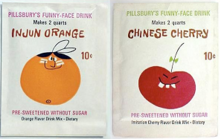Who Is the Little Kid in Funny Face Pillsberry Drink

Original packages for the two Funny Face flavors deemed offensive and soon replaced. "Injun" was a slang alteration of "Indian" (in reference to Native Americans), extant from the 17th into the 20th centuries, and now considered racist.[1] "Chinese Cherry" displays the exaggerated epicanthic fold and buck teeth typical of stereotypes of East Asians in the United States, extant in the 20th and into the 21st centuries,[2] particularly seen in American World War Two anti-Japanese propaganda,[3] [4] and now considered racist as well.[2]
Funny Face was a brand of powdered drink mix originally made and publicly sold by the Pillsbury Company[A] from 1964 to 1994,[5] and in limited productions (mainly in the Midwestern and New England regions of the U.S.A.) from 1994 to 2001. The brand was introduced as competition[6] to the similar (and more familiar and better-selling)[5] Kool-Aid made by Kraft Foods. The product came in assorted flavors sweetened with artificial sweetener,[B] and was mixed with water to make a beverage.
The product name "Funny Face" was based on the packaging and advertising created by Hal Silverman of the Campbell Mithun advertising agency.[7] [8] Each flavor was designated by a cartoon character with a presumably amusing face. The original flavors, and their names, were Goofy Grape, Rootin' Tootin' Raspberry, Freckle-Face Strawberry, Injun Orange, and Chinese Cherry. These last two, being ethnic stereotypes considered offensive by that time, were soon renamed to Jolly-Olly Orange and Choo Choo Cherry.[5] [6] Additional flavors were added later, including Captain Black Cherry, Chilly Cherry Cola, Lefty Lemonade (and Lefty Lemon-Lime), Loud Mouth Lime (and Loud Mouth Punch), Pistol Pink Lemonade, Rah-Rah Root Beer, Rudi Tutti-Frutti, Tart Lil' Imitation Lemonade, Tart 'N' Tangy Lemom, Tart 'N' Tangy Orange, With it Watermelon and Chug-a-Lug-a Chocolate,[9] the last intended to be mixed with milk rather than water.[10]
The mix was sweetened with calcium cyclamate. Cyclamates and their salts (including calcium cyclamate and sodium cyclamate) were banned in the United States in 1970;[11] Calcium cyclamate was briefly replaced by saccharin, which proved unpopular, after which the product was offered unsweetened.[10]
Various promotional tchotchkes were offered as premiums in support of the brand, such as mugs and pitchers bearing the likeness of the various cartoon faces associated with each flavor.[10] [12] [13] [9] A series of children's books such as "How Freckle Face Strawberry Got His Name" and similar titles were published.
The brand's tagline was "Funny Face is Fun To Drink!"[14] [15]
The Funny Face brand was purchased by Brady Enterprises in 1980, and continued to sell nationwide until 1994.[16] A limited production relaunch (albeit with some modifications) was briefly sold in selected areas from 1994 to 2001.
Notes [edit]
- ^
During the period covered by this article, the Pillsbury Company was an independent food company. It was purchased by Grand Metropolitan in 1989 and then by General Mills in 2001, by which time it was just a brand name used by General Mills (and by The J.M. Smucker Company, for some products).
- ^
Later in its existence the Funny Face line was sold unsweetened.
References [edit]
- ^ "Injun [definition]". Merriam-Webster Dictionary . Retrieved September 4, 2018.
- ^ a b "Snapchat's buck-toothed, slant-eyed Asian photo filter is blasted as 'yellow face' racism". South China Morning Post. August 11, 2016. Retrieved September 4, 2018.
- ^ Jen Quraishi Phillips. "Why the 'Tokio Kid' Wore Glasses, and Other Adventures in Anti-Japanese WW2 Propaganda". Medium . Retrieved September 4, 2018.
- ^ jeepersfreepers (June 1, 2016). "WWII American anti-Japanese Posters". imgur. Retrieved September 4, 2018.
- ^ a b c Todd Frye. "Funny Face drink mix". Todd Frye's Pop-Cult.com . Retrieved July 29, 2018.
- ^ a b Karlee Weinmann and Kim Bhasin (September 8, 2011). "12 Uncomfortably Racist Vintage Brand Mascots". Business Insider . Retrieved September 4, 2018.
- ^ Mayukh Sen. "Maybe These Pillsbury Drink Mix Mascots Are Best Left in 1965". Food52 . Retrieved September 4, 2018.
- ^ Dotz, Warren; Morton, Jim (1996). What a Character! 20th Century American Advertising Icons. Chronicle Books. p. 28. ISBN0-8118-0936-6.
- ^ a b "Chug-a-Lug-a Chocolate". Advertising Icon Museum. Retrieved September 4, 2018.
- ^ a b c Doug Smith (October 17, 2011). "Drink mix stirs up some sour stories". Quad-City Times ]Quad Cities] . Retrieved September 4, 2018.
- ^ Carlos Vincent Domingues, Alex Leybelman, and Julie M. Fagan (2014). "FDA's Persistent Ban on the Artificial Sweetener Cyclamate". Semantic Scholar. doi:10.7282/T3Z321J5. S2CID 10259279. CS1 maint: multiple names: authors list (link)
- ^ Mary Jane Lamphier (July 31, 2017). "Funny Face Drinks are more fun!". Collector's Journal . Retrieved September 4, 2018.
- ^ "Funny Face Cups (individual)". Pillsbury Funny Face [website] . Retrieved September 4, 2018.
- ^ Funny Face television advertisement on YouTube
- ^ Funny Face television advertisement, showing soon-discontinued Injun Orange and Chinese Cherry on YouTube
- ^ Brett Lang (August 8, 2009). "Funny Face gets animated". [Quincy, Massachusetts] Patriot Ledger . Retrieved July 29, 2018.
Cite error: A list-defined reference named "Decas" is not used in the content (see the help page).
Further reading [edit]
- Silverman, Hal (1966). How the Funny Face Characters Got Their Names. Pillsbury Corporation. (Children's book)
Source: https://en.wikipedia.org/wiki/Funny_Face_%28drink_mix%29
0 Response to "Who Is the Little Kid in Funny Face Pillsberry Drink"
Post a Comment